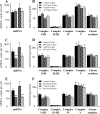Mitochondrial DNA depletion and respiratory chain activity in primary human subcutaneous adipocytes treated with nucleoside analogue reverse transcriptase inhibitors
- PMID: 19805555
- PMCID: PMC2798495
- DOI: 10.1128/AAC.00914-09
Mitochondrial DNA depletion and respiratory chain activity in primary human subcutaneous adipocytes treated with nucleoside analogue reverse transcriptase inhibitors
Abstract
Mitochondrial dysfunction as a consequence of mitochondrial DNA (mtDNA) depletion due to therapy with nucleoside analogue reverse transcriptase inhibitors (NRTI) has been proposed as a pathogenic mechanism leading to lipoatrophy in HIV-infected patients. The aim of our study was to investigate the impact of NRTI treatment on mtDNA abundance and the activities of respiratory chain complexes in primary human subcutaneous preadipocytes (phsPA). We studied adipocyte phenotypes, viability, and differentiation (CCAAT/enhancer-binding protein alpha [C/EBPalpha] and peroxisome proliferator-activated receptor gamma [PPARgamma] expression) and adiponectin production, mtDNA content, mitochondrial membrane potential, mitochondrial mass, and respiratory chain enzyme and citrate synthase activities in both proliferating and differentiating phsPA. Cells were exposed to zidovudine (6 microM), stavudine (d4T; 3 microM), and zalcitabine (ddC; 0.1 microM) for 8 weeks. NRTI-induced mtDNA depletion occurred in proliferating and differentiating phsPA after exposure to therapeutic drug concentrations of d4T and ddC. At these concentrations, ddC and d4T led to an almost 50% decrease in the number of mtDNA copies per cell without major impact on adipocyte differentiation. Despite mtDNA depletion by NRTI, the activities of the respiratory chain complexes, the mitochondrial membrane potential, and the mitochondrial mass were found to be unaffected. Severe NRTI-mediated mtDNA depletion in phsPA is not inevitably associated with impaired respiratory chain activity or altered mitochondrial membrane potential.
Figures




References
-
- Addy, C. L., A. Gavrila, S. Tsiodras, K. Brodovicz, A. W. Karchmer, and C. S. Mantzoros. 2003. Hypoadiponectinemia is associated with insulin resistance, hypertriglyceridemia, and fat redistribution in human immunodeficiency virus-infected patients treated with highly active antiretroviral therapy. J. Clin. Endocrinol. Metab. 88:627-636. - PubMed
-
- Bastard, J. P., M. Caron, H. Vidal, V. Jan, M. Auclair, C. Vigouroux, J. Luboinski, M. Laville, M. Maachi, P. M. Girard, W. Rozenbaum, P. Levan, and J. Capeau. 2002. Association between altered expression of adipogenic factor SREBP1 in lipoatrophic adipose tissue from HIV-1-infected patients and abnormal adipocyte differentiation and insulin resistance. Lancet 359:1026-1031. - PubMed
-
- Bensadoun, A., and D. Weinstein. 1976. Assay of proteins in the presence of interfering materials. Anal. Biochem. 70:241-250. - PubMed
-
- Brinkman, K., J. A. Smeitink, J. A. Romijn, and P. Reiss. 1999. Mitochondrial toxicity induced by nucleoside-analogue reverse-transcriptase inhibitors is a key factor in the pathogenesis of antiretroviral-therapy-related lipodystrophy. Lancet 354:1112-1115. - PubMed
-
- Caron, M., M. Auclair, C. Lagathu, A. Lombes, U. A. Walker, M. Kornprobst, and J. Capeau. 2004. The HIV-1 nucleoside reverse transcriptase inhibitors stavudine and zidovudine alter adipocyte functions in vitro. AIDS 18:2127-2136. - PubMed
Publication types
MeSH terms
Substances
LinkOut - more resources
Full Text Sources
Other Literature Sources

